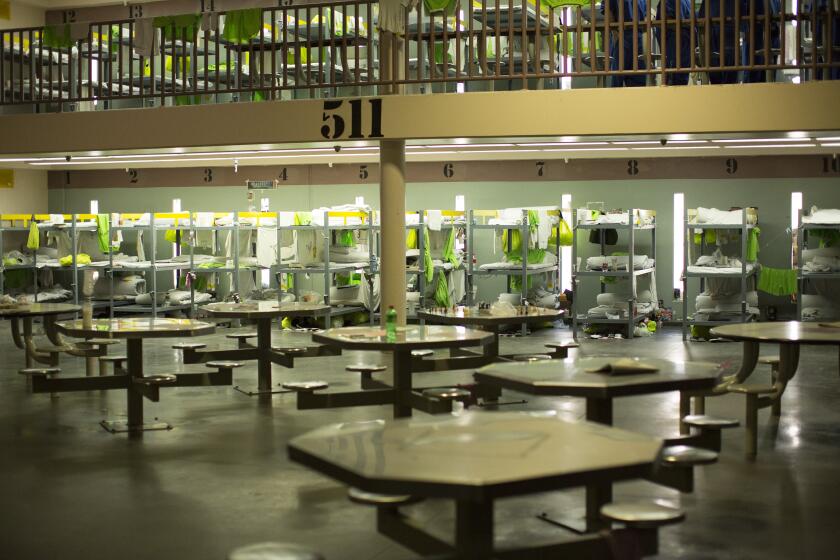Capitol Journal: Gov. Brown preaches adaptation but ducks big fights
- Share via
in sacramento — Gov. Jerry Brown speaks passionately about how humans — Californians specifically — must adapt to changing conditions or become extinct. Hopefully he is listening to himself.
Because, frankly, I haven’t noticed the governor adapting much in order to confront California’s modern challenges. His record is spotty at best.
When he preaches adaptation, the context is global warming, including its uncertain potential for frequent droughts. But there also are other nagging, parochial problems that require new attitudes if this state is to restore its golden sheen.
Brown gets credit for holding back fellow Democrats on spending, although he is plowing ahead with two massive, questionable and costly pet projects: the bullet train and twin water tunnels.
He coaxed voters into raising taxes on the rich — meaning mostly not themselves — to patch a bleeding state budget.
He pushed through legislation to spend extra money educating the poor and non-English speakers, although this could shortchange middle-class kids struggling to prepare for an increasingly technical world.
But on such politically risky problems as tax reform and regulatory streamlining — needed to stabilize state financing and make California more business-friendly and productive — Brown has ducked out of sight.
Our once-enviable highways are wrecks. We need a 21st century funding scheme to keep up with wear and tear. But Brown has been parked on a side road.
New schools need to be built and old ones modernized. But he’s in recess.
And concerning those legacy-building train and tunnel projects, the governor seems inflexible, ignoring critics and unwilling to alter his plans in ways that could forge a supportive consensus.
All this came to mind last week as I listened to Brown wax poetic about the necessity for humans to adapt. The occasion was a televised interview conducted by Los Angeles Times Publisher Austin Beutner at USC. The Q&A focused on the drought but also veered into global warming.
“Like every other species,” Brown said, “we have to adapt to whatever the environment is that we’re thrown into. And we adapt or we disappear.”
Species “that have successfully evolved and are still in the game of life,” Brown continued, “they mutate themselves. They don’t try to change the world. They change to get on the side of nature.... We will have to change our ways — maybe not how our chromosomes work, but at least how we eat and how we clothe and recreate.... We’re going to create a more elegant way of interfacing with the rest of nature.”
He characterized the drought as “just a tiny, tiny foretaste of what’s to come.”
A dire prognosis.
Brown, in fact, is trying to change California’s energy-burning habits, although he also acknowledged last week that “the problem is Californians can’t do it alone. We’re 1% of the climate pollution in the world.”
He has set a 15-year goal of cutting California petroleum use in half and relying on renewable energy for half our electricity. That’s good because the State Water Project is the single largest energy hog in California.
As for the drought, Brown told Beutner that Californians need to “take water and use it and use it again and use it again. The metaphor is spaceship Earth. In a spaceship you reuse everything.”
OK, but where’s the state’s crash recycling program?
And about all we’ve heard from the governor regarding adaptation to less water use are lectures to cut back on lawn sprinkling, taking shorter showers and not flushing as much.
If we stopped all that completely, it would save less than 10% of our developed water. And we’d be pretty cranky.
Agriculture accounts for 80% of human water use in California while generating only 2% of the economy. If we really must adapt or perish, why isn’t Brown seriously considering regulating which thirsty crops can be grown and where?
Nut and fruit orchards in the semi-arid San Joaquin Valley require significantly more irrigation than the same trees in the wetter Sacramento Valley. Some land should be converted to solar farming.
In much of the San Joaquin, aquifers are being dangerously over-pumped and, in spots, the land is precipitously sinking. Brown signed legislation last year to regulate groundwater pumping. But that won’t kick in for two decades. Why not expedite it?
“We’re moving forward,” Brown said. “Whether it’s fast enough, ask me in another year.”
The two 35-mile, 40-foot wide tunnels that would carry water under the Sacramento-San Joaquin Delta — a $17-billion project paid for on consumers’ water bills — are necessary, Brown asserted, because levees could collapse in an earthquake or as the sea rises in global warming. That could draw sea water into California’s primary fresh water pool.
Never mind that no earthquake in history has seriously harmed a delta levee. But if the levees are that fragile, where’s the urgent effort to bolster them? And if the sea rises that much, it also will wreak havoc with Malibu and Newport Beach, among other coastal communities. What are we doing about that?
Those tunnels are just another version of the old Peripheral Canal that Brown’s father, Gov. Pat Brown, first proposed half a century ago and Jerry promoted when he was governor the first time. Voters rejected it.
“This is the time, now or never, to get it done,” the governor said. “If we don’t get it this time, it’ll be another 40 years.”
Here’s an idea: Try something new that’s smaller, less expensive and more acceptable. Adapt.
Twitter: @LATimesSkelton
More to Read
Sign up for Essential California
The most important California stories and recommendations in your inbox every morning.
You may occasionally receive promotional content from the Los Angeles Times.











